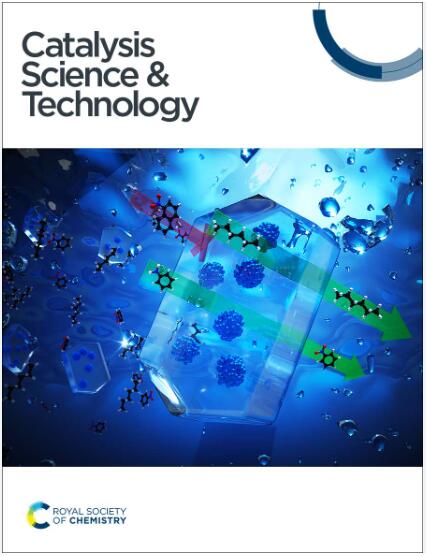通过底物和辅因子结合袋周围残基的空间修饰改善了还原氨基酶的立体控制
IF 4.4
3区 化学
Q2 CHEMISTRY, PHYSICAL
引用次数: 0
摘要
由还原氨基酶催化的不对称还原胺化反应为合成2°和3°手性胺提供了一条绿色、直接的途径。识别这些酶中促进立体控制的残基或基序对于设计高度理想的对映发散式ream系统至关重要。在这项工作中,我们已经确定了真菌还原氨基酶(MaRedAm)和细菌亚胺还原酶(AoIRED)的辅因子和底物结合袋中的关键残基,这些残基可以通过立体修饰实现立体控制。在MaRedAm中,通过W33A或R35A突变去除辅因子结合袋处的立体块,提高了(R)-雷沙吉兰合成的(R)-选择性,实现了高达95%的对映体过量(e.e)。相反,MaRedAm底物结合袋处的W211A突变逆转了立体选择性,产生(S)-雷沙吉兰(42% e.e)。同样,在AoIRED中N241位置的空间体积变化允许对映散。值得注意的是,修改N241的位置显著提高了AoIRED的溶液稳定性和可储存性。野生型酶通常在纯化后8小时内从溶液中析出,即使在4°C下保存也是如此,而其N241H和N241Y变体在溶液中保留长达1周。分子动力学(MD)模拟提供了立体修饰对辅因子和底物结合袋的立体选择性影响的详细见解。MaRedAm W33A和W35A突变诱导了活性位点的重组和缩小,增强了(R)选择性。相比之下,W211A突变扩大了底物结合袋,增加了底物旋转的灵活性。这些发现有助于建立关键残基的功能作用,从而有效合理地设计ired / redam的立体选择性。本文章由计算机程序翻译,如有差异,请以英文原文为准。
Improved stereocontrol in reductive aminases through steric modification of residues around substrate and cofactor binding pockets†
Asymmetric reductive amination catalysed by reductive aminases (RedAms) provides a green and direct route to 2° and 3° chiral amines. Identifying residues or motifs in these enzymes that facilitate stereocontrol is essential for designing highly desirable enantiodivergent RedAm systems. In this work, we have identified key residues within both the cofactor and substrate binding pockets in a fungal reductive aminase (MaRedAm) and a bacterial imine reductase (AoIRED) that enable stereocontrol through steric modification. In MaRedAm, removing steric bulk at the cofactor binding pocket via W33A or R35A mutation improved (R)-selectivity towards the synthesis of (R)-rasagiline, achieving up to 95% enantiomeric excess (e.e.). Conversely, the W211A mutation at the substrate binding pocket of MaRedAm inverted the stereoselectivity, yielding (S)-rasagiline (42% e.e.). Likewise, varying steric bulk at position N241 in AoIRED allowed for enantiodivergency. Notably, modifying the N241 position significantly improved AoIRED's solution stability and storability. The wild-type enzyme typically precipitates out of solution within 8 h after purification, even when stored at 4 °C, whereas its N241H and N241Y variants remain in solution for up to >1 week. Molecular dynamics (MD) simulations provided detailed insights into the effect of steric modification on stereoselectivity at the cofactor and substrate binding pockets. MaRedAm W33A and W35A mutations induced reorganisation and downsizing of the active site, enhancing (R)-selectivity. In contrast, the W211A mutation enlarged the substrate binding pocket, increasing flexibility for substrate rotation. These findings contribute to the ongoing effort to establish the functional roles of key residues to allow efficient rational engineering of stereoselectivity in IREDs/RedAms.
求助全文
通过发布文献求助,成功后即可免费获取论文全文。
去求助
来源期刊

Catalysis Science & Technology
CHEMISTRY, PHYSICAL-
CiteScore
8.70
自引率
6.00%
发文量
587
审稿时长
1.5 months
期刊介绍:
A multidisciplinary journal focusing on cutting edge research across all fundamental science and technological aspects of catalysis.
Editor-in-chief: Bert Weckhuysen
Impact factor: 5.0
Time to first decision (peer reviewed only): 31 days
 求助内容:
求助内容: 应助结果提醒方式:
应助结果提醒方式:


